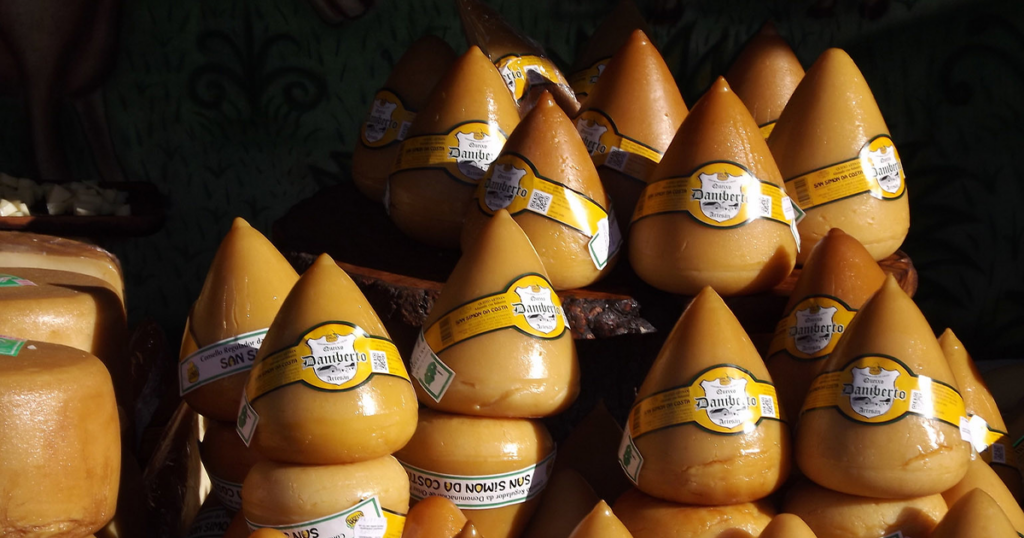
It was a damp and windy Saturday afternoon when my race partner and I arrived in Arzúa, a village in Galicia, for a footrace the next day. For us, driving three or four hours to a new town for a race is a good way to spend a weekend, especially if we have time to explore before or after the race. We’d given ourselves lots of time in Arzúa, but we’d forgotten about the weather.
The race finish line was at the Magdalena chapel, so we parked on a nearby street. The next morning, we would pick up our race bibs at the chapel, then take a bus provided by the race organizers to the starting line, some 15 kilometers away in Melide. There we would start back along a 13-kilometer stretch of the Camino de Santiago, a winding path that dipped into a forest, forded a stream, crossed some rolling meadows, and climbed some hills, passing through several villages along the way, to end up back at the Magdalena chapel. Between now and then, we were free to feast on the local sights and sounds, and especially the tastes.
The race was the first edition of the Carreira Terra do Queixo, land of cheese race, in recognition of the local cheese, produced and sold under the protected denomination Arzúa-Ulloa. The following weekend, the town would celebrate the 50th edition of the festa do queixo to promote the cheese. Banners announcing the upcoming festival were already hanging from light posts and strung across several plazas, flapping in the wind like clothes on a line. Had the clothes been yours, you’d have wanted to bring them in because it looked like rain. We had all afternoon to explore the town of about 6,000 inhabitants, but we didn’t tarry, hoping to see something before we got rained out.
A good place to start out in any town is the market, so we set off at a fast walk, and soon found it. Appearing more like an exhibition hall than a marketplace, it was a large, charmless, drafty enclosure beside the town’s central plaza. We made a quick circle through it, past the bread stands on either side of the door, the vegetable vendors in the center, the meat stands along one side, and the cheese stands along the other. Very few customers were present, and the energy was low, making it feel like the end of a party but without the residue of cheer. Many vendors were packing up and hardly aware of a couple of new shoppers. But the cheese vendors, most with just two types and sizes of cheeses, white or creamy yellow and small or medium, had little to put away. They still stood behind their rickety folding tables, a surly-looking lot.
So! This was what we had come for. The local experience. Obviously, cheese was the order of the day, so after our cursory inspection, we drifted toward a stand with an elderly man who had tried to lure us over our first time through.
On his table were about 15 firm yellow cheeses, each around eight inches in diameter and two inches high, a similar number of white cheeses, and some smaller yellow cheeses. “One of each,” said my partner, indicating the two principal piles. The man gave us a humorous but pitying look and, reaching for a plastic bag, said, “No, two of each.” He put two yellow cheeses in one bag and two white in another.
We laughed in surprise at his confident maneuver. Okay, fine.
“What else?”
We shook our heads. “Nothing.” My partner asked the price and, when the man said 22 euros, pulled out a 50-euro bill.
“And one of these,” said the man, putting a small cheese in the bag, “to bring it to 25.”
I was still marveling at how the vender had sold us twice as much as we’d asked for, and now he’d increased the sale again. My friend’s laugh was as good as an “okay,” and he held out the bill.
The vendor grabbed another cheese, a popular Galician cheese called tetilla, nipple cheese, that takes its name from its shape. For 10 euros you can pick up a tetilla in any chain grocery store, produced industrially, and here he was, putting the much higher-quality cheese in the bulging bag and saying the addition would make the total an easy 30 euros.
But enough is enough.
“No, no, no,” my friend said. “No. De verdad, no.”
The vendor shrugged, placed the cheese back on the table, took the bill, and gave back the change. He handed over the two bags. We said goodbye, carrying our 10 pounds of cheese purchased for just over 25 dollars. Out into the weather, which blew up into squalls from time to time throughout the afternoon. What else did we see? A restaurant for lunch, a bar for coffee, a field, two rabbits in a yard, and the inside of a general store where we picked up two rain shells for the next day, just in case. Dark clouds and the hatching of rain. Rain pinging on the vehicle and on the street. And that was the extent of our sightseeing.
After the race the next day, I received two more cheeses, one in lieu of a trophy for first place in my category and the other for participating. Back home, I gave my neighbor a cheese and recounted the market story to him, and he chuckled. “Those Gallegos!” His tone was slightly admiring, slightly exasperated. He shook his head. Then he said he knew the town, very pretty, and said he loved Galician cheese, declaring the cheese from Arzúa to be excellent. He thanked me. I said I had cheese coming out of my ears. Those Gallegos! Twice as much cheese, twice as good, and at half the price! We all made out in that exchange.


